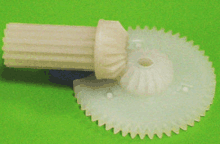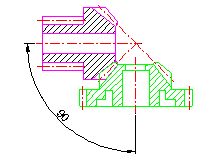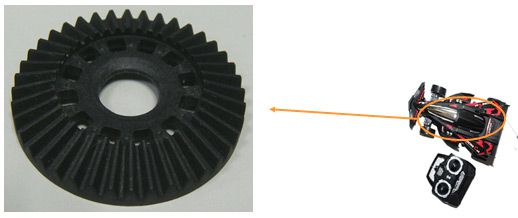Plastic Bevel Gear


Features of Bevel Gears:
Bevel gears are widely designed to transmit power and motion between intersecting axes, generally at right angles. Therefore bevel gears are suitable when the transmitting direction needs to be changed. The teeth on a bevel gear can be straight, spiral or hypoid.
Bevel Gears Specifications:
| Type | Plastic Bevel Gear |
|---|---|
| Module | M0.1 - M2.0 |
| Material | Polyacetal (POM) / Nylon |
| Bore | Ø1.40mm/ Ø1.90mm/ Ø2.05mm/ Ø2.40mm/ Ø2.55mm / Ø2.90mm/ Ø3.05mm(Flexible) |
| Outer Diameter | Ø3.0mm - Ø100.0mm (Flexible) |
| Face Width (L) | 4.0mm - 20.0mm (Flexible) |
Inquiry: Please provide gear specifications.
Yeh Der provides handmade/ machined custom gears, so tests of gears can be done before mold making.
Our plastic gears meet all kinds of needs for laser printers, digital cameras, scanners, CD-ROMs, stepping motors, medical equipment, vending machines, gear pumps, household appliances, fax machines, watches, toys, etc and for other specialized products.

-
Specification
Item M0.8-40T Bevel Gear Material REENI PA-G-4150A Module M0.8 No. of Teeth 40T Weight 2.90g / pcs Application Remote Control Cars
About Plastic Gears
A gear is a toothed wheel designed to transmit force to another gear or toothed component. The teeth of a gear can be shaped to minimize wear, vibration and noise, and to maximize the efficiency of power transmission.
Gears of differing size are often used in pairs for a mechanical advantage, allowing the torque of the driving gear to produce a larger torque in the driven gear at lower speed, or a smaller torque at higher speed.
The Advantages of Plastic Gars:- Plastic gears are easily molded into various shapes so they have wider range of configuration.
- Plastic gears are less expensive and are lighter in weight.
- Plastic gears are chemical and corrosion resistant.
- Plastic gears have quieter and smoother operation and offer more efficient drive geometry.
- Plastic gears are with inherent self lubricating.
While plastic gears offer these many advantages over metal gears, their effective use requires proper design and engineering to account for possible dimensional and property variations over the expected range of operating conditions.





